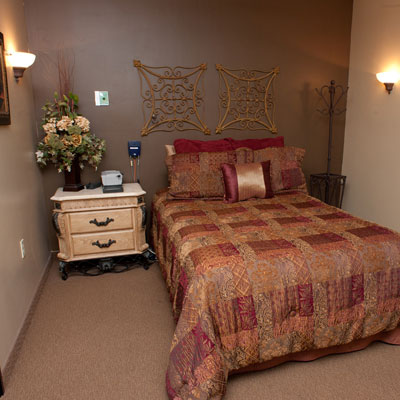SLEEP SERVICES

Valley Sleep Center provides sleep studies in Arizona
Valley Sleep Center Sleep testing suites offer a homelike atmosphere and include a private bathroom, Cable Television, Wireless internet, and most rooms offer a motorized bed for convenience/comfort.
The treatment and testing equipment utilized in the sleep center exceeds American Academy of Sleep Medicine recommendations to provide patients with top tier sleep recordings for analysis by our Sleep Physicians.
All Valley Sleep Centers are Accredited by the American Academy of Sleep Medicine and are staffed primarily by Board Certified Sleep Physicians and Registered Polysomnographic Technologists.
Valley Sleep Center offers a wide range of options for sleep testing as well as Treatment options like Inspire Therapy, Continuous Positive Airway Pressure (CPAP), Mandibular Advancement Devices (Dental Appliances), and other Technologies as they are available.
Listed below are the current Testing Options available at Valley Sleep Centers
Adult Polysomnography
This study is performed without the initiation of Positive Airway Pressure (PAP) therapy during the night. This study may include analysis of Inspire Therapy, Mandibular Advancement Therapy, and other non-PAP Treatments.
Pediatric Polysomnography
EtCO2 monitoring is generally performed on Pediatric Polysomnography Tests. This study is performed without the initiation of Positive Airway Pressure (PAP) therapy during the night
.
Split Polysomnography
This Study Type is unique in that it monitors the patient in the first half of the night (Baseline) and then allows for the initiation of Positive Airway Pressure (PAP) to be initiated and Titrated in the second half of the night to treat Sleep Apnea. Most sleep testing is ordered as a Split Night Polysomnography.
Titration Polysomnography
This test is ordered once a patient has already qualified for PAP therapy and needs additional time to obtain an optimal Titration or has a re-occurrence of symptoms and needs adjustments made to the PAP therapy levels during monitored sleep.
Multiple Sleep Latency Testing
Maintenance of Wakefulness Testing
This test is used to monitor a patient’s oxygen levels and heart rate at night. This test may be ordered to assess current oxygen use in the home or to evaluate the need for oxygen at night.
Home Sleep Testing
The Home Sleep Apnea Test if very effective and looking for the typical snoring and breathing pauses seen with Sleep Apnea and is less expensive and convenient as it is performed in the patient’s home.
An in-lab test may be required for patients with other Sleep Disorders or those who have Heart, Respiratory, and/or Neurological medical conditions.
ApneaLink is used to monitor a patient’s oxygen levels and heart rate during the night. An ApneaLink is similar to a nocturnal oximetry; however, the ApneaLink provides doctors with additional screening signs that indicate the possibility of sleep apnea at night.
REQUEST A CONSULTATION
For most insurance plans, you do not need a primary care referral to meet with our board certified sleep physicians.

